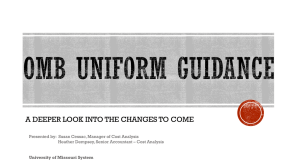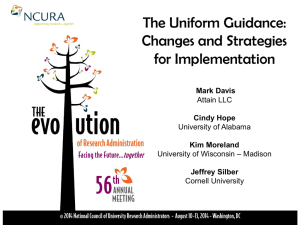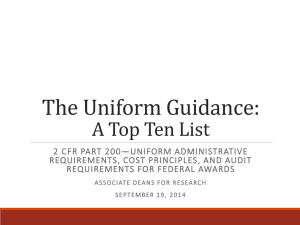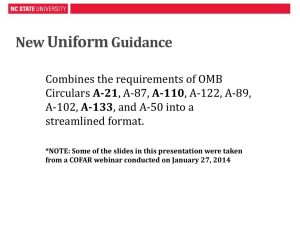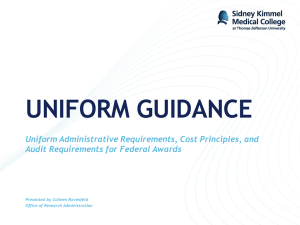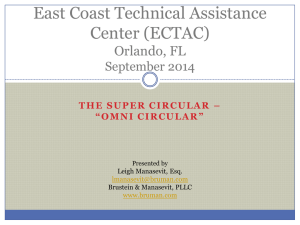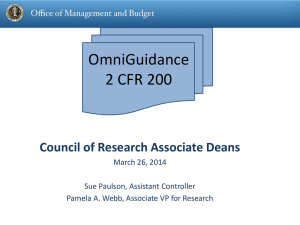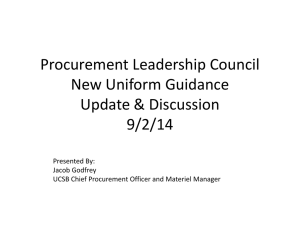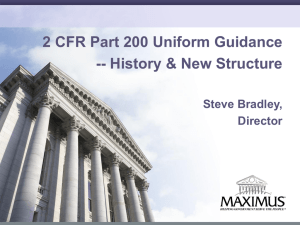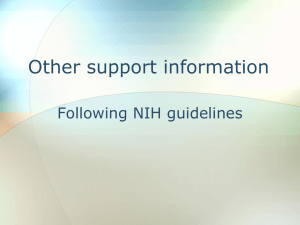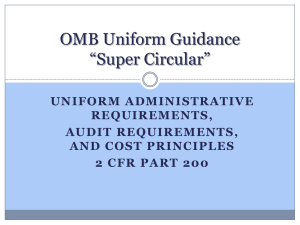Uniform Guidance: Key Issues for Universities (NCURA Webcast
advertisement
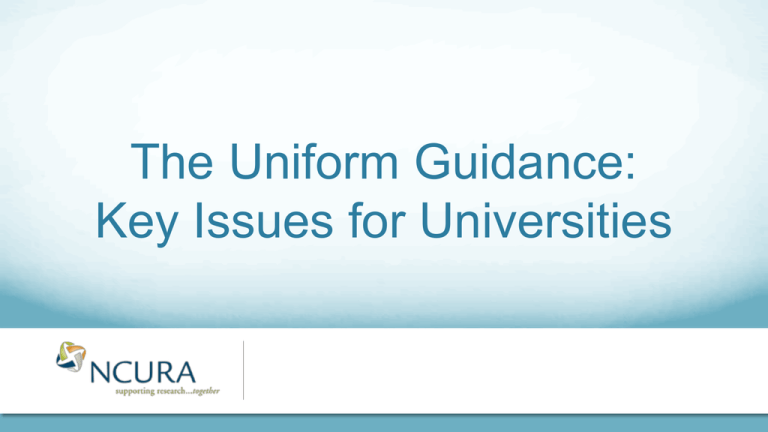
The Uniform Guidance: Key Issues for Universities Slide 1 Today’s Panel Michelle Christy, Director, Office of Sponsored Programs, Massachusetts Institute of Technology David Kennedy, Director of Costing Policies and Studies, Council on Governmental Relations Cindy Hope, Assistant Vice President for Research, University of Alabama Jim Luther, Associate Vice President, Research Cost Compliance, Duke University Mark Davis, Vice President for Higher Education, Attain Kim Moreland, Assoc. Vice Chancellor for Research and Sponsored Programs, University of Wisconsin - Madison Slide 2 The Uniform Guidance The single biggest regulatory change in the last 50 years of research administration How is the Uniform Guidance like a big volcano? Slide 3 Mauna Kea, Hawaii, The Big Island Mauna Kea: What’s below the surface? Big Volcano Big Document 13,796 feet above sea level 19,700 feet below sea level Nearly a mile taller than Mt. Everest Compilation of 8 circulars Major changes in regulations Included input from stakeholders Good News: Good News: Eruptions include earthquakes and lava. Hasn’t erupted in 4500 years Eruptions include auditors and fines. We are all in this together! Slide 6 UG: Above Ground and Below the Surface What does the Guidance say? What are the areas that need clarification or explanation? How will the audit community 33,465 FT interpret the Guidance? What should we be doing on my campus? Sea Level 13,793 FT above Sea Level 18,000 FT below Sea Level What can I expect going forward? Slide 7 Outline of Uniform Guidance Subpart A – Definitions Subpart B – General Provisions Subpart C – Pre-Award Subpart D – Post Award Subpart E – Cost Principles Subpart F – Audit Requirements Appendices I - XI Slide 8 Michelle Christy Massachusetts Institute of Technology Slide 9 200.102 Subpart B, General Provisions - Exceptions 200.102 – Exceptions – Rates and Reporting Allows agencies to make exceptions, but they must to be posted on the OMB website Careful monitoring! And be sure to contact OMB with your ideas about exceptions Who to talk to @ OMB? % Slide 10 200.110 Subpart B, General Provisions - Applicability 200.110 – Applicability and Dates Uniform implementation date of 12/26/14 for all Subparts, except Subpart F, which will be effective the first FY beginning after 12/26/14 Generally speaking, the UG will be applicable for new awards and for incremental funding awarded on or after 12/26/14 Open question remains on how dates apply to negotiating new F&A rates and awards that are not modified after 12/26/2014 Slide 11 200.112 Subpart B, Conflict of Interest 200.112 – Conflict of Interest Sets new standards for COI policies for Federal awarding agencies, including disclosure to the awarding agency of potential conflicts of interest NSF and NIH already meet the new standard – no changes anticipated I COI How will other agencies respond? Do you make distinctions between sponsors at your institution? Slide 12 200.202/203 Subpart C, Pre-Award 200.202/203 – Funding Opportunities Provides standards for information needed in each funding opportunity – not new 30-60 DAYS Agencies must generally post opportunities at last 60 calendar days prior to due date, but …. no opportunities should be available for less than 30 calendar days Slide 13 200.210 Subpart C, Terms and Conditions 200.210 – Terms and Conditions for Federal Awards REQUIRED Requires the awarding agency to incorporate general terms and conditions either in the award or by reference – nothing new, BUT! Research Terms and Conditions (RTC) expire 12/26/2014 FDP is forming a group to work with federal officials to secure new or existing RTC terms Slide 14 200.301 Subpart D, Post Award – Performance Data 200.301 – Performance Measurement and Financial Data Recipients must comply with OMB-approved governmentwide standard information collections when providing financial and performance information Clear directive/more pressure for funding agencies to relate financial data to performance requirements of the federal award and provide cost information to demonstrate cost effective practices (e.g. unit cost data); Refer agencies to 200.76 and 200.210(d) which allows agencies to limit reporting to a technical performance report for discretionary research awards (i.e. RPPR) Higher reporting bar for Federal contracts – alert your PIs! Slide 15 200.303 Subpart D, Post Award – Internal Controls 200.303 – Strong emphasis on internal controls Requires recipients to have strong internal controls; should be in compliance with … COSO or the Federal “Green Book” NOTE: COFAR clarified in the recent FAQ: there is no expectation or requirement that internal controls be documented or evaluated prescriptively to these guidelines – use as a source for best practices – SOX What is the control structure at your institution? Centralized? Decentralized? Are you getting rigorous A-133 audits? If not, look at your procedures carefully! Slide 16 200.306 Subpart D, Post Award – Cost Sharing 200.306 – Cost Share Good: Restrictions on voluntary committed cost share! No more statements of cost sharing being “encouraged.” It must be explicitly described in merit criteria Impact on the base for F&A? To be discussed in F&A section Specific guidance on valuing third party cost share and counting unrecovered F&A as cost share (only with approval!) Also, changes in the definition of a subcontract and mention of "participant costs” as being exempt from F&A Slide 17 David Kennedy COGR Slide 18 200.307 Subpart D, Post Award – Program Income 200.307 – Program Income The default to the Addition method for IHEs and nonprofit research institutions standardizes this treatment of program income The definition of Program income (see 200.80) includes “license fees and royalties on patents and copyrights” and is consistent with A-110 … HOWEVER … A-110, .24(h), states that recipients are under no obligation to treat licensing/royalty revenue as program income, unless the terms and conditions of the award state otherwise … No such language in the Uniform Guidance Raises an inconsistency between the Uniform Guidance and the Bayh-Dole Act (35 USC 202(c)(7)) Slide 19 200.313 Subpart D, Post Award – Equipment 200.313 – Equipment New or subtle changes in terminology between A-110, section .34, and the Uniform Guidance may require clarification “Conditional title” is new. Preliminary assessment is that “conditional title” always has been effective, though not explicitly named in A-110 “Percentage of Federal participation in the project costs” (A-110 required the “percentage of Federal participation in the cost of the equipment”) and “use and condition” (“use” is not included in A-110) are new. Preliminary assessment is that the intent was not to create burden by requiring new data fields and that the subtle changes in terminology will not require systems changes to the institution’s equipment inventory system. Slide 20 200.318 Subpart D, Post Award – Procurement 200.318 – General Procurement Standards The requirement in section (i), “The non-Federal entity must maintain records sufficient to detail the history of procurement,” may be a burdensome requirement to document the history of the procurement actions, and it is uncertain as to how this will be implemented at institutions The Procurement standards in sections 200.317 through 200.326 represent a significant change from Circular A-110 and represent a potential new administrative burden for IHEs and nonprofit research institutions This will be a major focus of organizations, such as COGR, leading up to the implementation of the Uniform Guidance on December 26, 2014. Slide 21 200.319 Subpart D, Post Award – Competition 200.319 – Competition (note: (b), (c), and (d) are new) (a) All procurement transactions must be conducted in a manner providing full and open competition consistent with the standards of this section … (b) The non-Federal entity must conduct procurements in a manner that prohibits the use of statutorily or administratively imposed state or local geographical preferences ... (c) The non-Federal entity must have written procedures for procurement transactions. These procedures must ensure ... (d) The non-Federal entity must ensure that all prequalified lists of persons, firms, or products … are current and include enough qualified sources to ensure maximum open and free competition … Slide 22 200.320 Subpart D – Methods of Procurement 200.320 – Methods of Procurement (the “hot topic” under Procurement) Institutions must use one of the five procurement methods. These methods are much more detailed and prescriptive in comparison to the requirements in A-110. Method (a): “Micro-purchase” (defined in Subpart A Definitions, 200.67); $3000 or less and is designed to expedite small purchase transactions. Method (b): Simplified Acquisition Threshold ($150,000); “Price or rate quotations are required from an adequate number of qualified sources”. Methods (c) and (d) include detailed requirements associated with sealed bids (c) and competitive proposals. Method (f): Sole source procurement and the circumstances (at least one of four) that should be applicable in order to use the sole source method. Slide 23 Cindy Hope University of Alabama Slide 24 200.330 Subrecipient and Contractor Determinations Pass-through entities Subrecipient: • Has performance measured against the objectives of the Federal must make determinations “Contractor” has replaced “vendor” Characteristics of a subrecipient and of a contractor (vendor) have not changed • • • • program Has responsibility for making programmatic decisions Has responsibility for adherence to Federal program compliance requirements Uses Federal funds to carry out a program of the organization, not to provide goods or services for a program of the pass-through entity Determines who is eligible to receive Federal financial assistance Professional Service/Vendor: • Provides the goods or services within normal business operations • Provides similar goods or services to many different purchasers • Operates in a competitive environment • Provides goods or services that are ancillary to the operation of the Federal program • Is not subject to compliance requirements of the Federal program Slide 25 200.330 Subrecipient and Contractor Determinations Federal agencies may supply and require specific support for determinations Could create a significant documentation burden Could result in unintended agency influence on determinations Slide 26 200.331 Requirements for Pass-through Entities All pass-through entities must… (a)(1) Federal Award Identification List of information required to be included in each subagreement Includes more elements, many related to compliance with FFATA Slide 27 200.331 Pass-through Entities – Indirect Costs All pass-through entities must… (a)(4) Indirect cost rate If the subrecipient has a federally recognized, negotiated rate, use it. If not: Negotiate a rate with the subrecipient or Use the de minimus rate of 10% MTDC Slide 28 200.331 Pass-through Entities – Risk All pass-through entities must… (b) Evaluate subrecipient risk to determine appropriate monitoring Factors to consider may include subrecipient’s Previous experience Audits (Single audit threshold now $750K) Personnel or system changes Monitoring by federal agencies Slide 29 200.331 Pass-through Entities – Monitoring All pass-through entities must… (d) Pass-through entity monitoring of the subrecipient must include: Review financial and programmatic reports Related to the Federal award provided from the pass-through: Ensure appropriate action is taken when deficiencies are detected Issue management decisions when the subrecipient has audit findings Slide 30 200.331 Pass-through Entities – Tools All pass-through entities must… (e) Based on assessed risk, these monitoring tools may be useful for the pass-through, including Training and technical assistance, on-site reviews, agreedupon procedures audits (f)&(g) Still required to verify compliance with Subpart F, Audit, and adjust own records if necessary Slide 31 200.332 Fixed Amount Subawards – Limits Fixed amount awards defined at 200.45 “a specific level of support without regard to actual cost incurred” Accountability based primarily on performance and results Allowed “with prior written approval from the Federal awarding agency” “Up to the Simplified Acquisition Threshold” Defined at 200.88, currently $150,000 Slide 32 200.332 Fixed Amount Subawards Like now, amount of award is negotiated based on cost: 200.201 - may use fixed amount subawards where there is adequate data “to establish a fixed amount award with assurance that the non-Federal entity will realize no increment above actual cost” Like now, amount charged is not based on cost 200.400(g) - the non-Federal entity may not earn or keep profit Remember: Based on 200.401, Subpart E, Cost Principles, does not apply to fixed amount awards Slide 33 200.335 Collection, Transmission, Storage of Information No need to create a paper record for a record that was 2013 Executive Order on Making originally electronic and Open and Machine Readable cannot be altered the New Default for Government Information - collect, transmit, and store Federal award-related information in open and machine readable formats rather than in closed formats or paper. Slide 34 200.335 Information – Electronic Records 2013 Executive Order May convert paper to electronic provided the records are: subject to periodic quality control reviews provide reasonable safeguards against alteration, and remain readable Remember the administrative requirements in this guidance do not apply to contracts. FAR requirements have not changed. Slide 35 200.343 Closeouts No stated change for recipient, but… All reports due “no later than 90 calendar days after the end date of the period of performance” New circumstances Pressure on agencies (OMB 7/2012 Controller Alert) Subaccounting (NSF, NIH, others) Enforcement through 90 days for cash draw Closeout is the focus of a new FDP/COGR group Slide 36 Jim Luther Duke University Slide 37 200.413 Direct Costs – (c) Clerical and Administrative (c) “The salaries of administrative and clerical staff should normally be treated as indirect (F&A) costs. Direct charging of these costs may be appropriate only if all of the following conditions are met: Administrative or clerical services are integral to a project or activity; Individuals involved can be specifically identified with the project …; Such costs are explicitly included in the budget or have the prior written approval of the Federal awarding agency; and . . . . The costs are also not recovered as indirect costs. Note: Removal of “major project” requirement Recognition of administrative workload Slide 38 200.413 Direct Costs – (c) Clerical and Admin Interpretations and Considerations This section should be read in conjunction with Appendix III, B.6.a. & 200.430 (i) What does “integral” mean? Is this the same as allocable? Allowable? Does “explicitly included in the budget” mean that we can’t rebudget after award without sponsor approval? Do you have controls to ensure items are in the budget or to ask the sponsor later? Do you have adequate controls to manage the drawdown? Are you changing your accounting treatment? Do you need to disclose in your CASB DS-2? Upon distribution of agency implementation plans, further review may be needed NOTE: Institutions may consider proposing these costs in funding applications that would be funded on or after December 26, 2014 Slide 39 200.414 Indirect (F&A) Rates – (c) Rate Acceptance • (c) Federal Agency Acceptance of Negotiated Indirect Cost Rates • (1) The negotiated rates must be accepted by all Federal awarding agencies. A Federal awarding agency may use a rate different from the negotiated rate…only when required by Federal statute or regulation, or when approved by a Federal awarding agency head… • (2) … agency head or delegate must notify OMB of any approved deviations. • (3) … agency must implement, and make publicly available…criteria that their programs will follow to seek and justify deviations… • Consideration/Interpretation • • • • Does this apply to “Genomic Array” situations? Others situations? How do institutions escalate for resolution? If exceptions do occur, can your ledger support? Calculation of F&A? Appropriate handling in MTDC? Slide 40 200.414 Indirect (F&A) Rates – (g) 4 year Extension • (g) Any non-Federal entity that has a federally negotiated indirect cost rate may apply for a one-time extension of a current negotiated indirect cost rate for a period of up to four years. This extension will be subject to the review and approval of the cognizant agency for indirect costs. If an extension is granted the non-Federal entity may not request a rate review until the extension period ends. At the end of the 4-year extension, the non-Federal entity must re-apply to negotiate a rate. • Interpretation/Considerations • What level of documentation is required for the extension? • Can institutions extend portions but not the whole rate? Slide 41 200.430 Compensation – Personal Services Preamble on pages 78601 of the Federal Register is very informative Demonstrates that COFAR adjusted regulations based on IHE input and tried to balance with regulator’s perspective More flexibility but a requirement to “comply with a stringent framework of internal control objectives and requirements” Acknowledges that many entities may continue to rely on existing procedures and systems Emphasis on written policies Slide 42 200.430 Compensation – Effort Reporting More Flexibility: No requirement for “activity/effort reports.” Removed reference to “certification/certify” Eliminated: J.10.c(1)f: requirement for “independent internal evaluation” and examples of acceptable Methods for Payroll Distribution Added: Concept of IBS: (ii) The non-Federal entity establishes a consistent written definition… Allowable activities: Added language to allow for “developing and maintaining protocols,” “managing and securing project-specific data, coordinating research subjects…” (2) For records that meet the standards …not be required to provide additional support or documentation for the work performed… Slide 43 200.430 Compensation – Internal Controls But stringent framework of internal controls… “Control” or “Internal Control” is mentioned 16 times in the preamble “This final guidance requires non-Federal entities to comply with a stringent framework of internal control objectives and requirements.” Reasonable assurance that charges are accurate, allowable, and properly allocated Emphasis on written policies and “consistent definition of work covered by IBS” Continued focus on “processes to review after-the-fact.” Must reflect the work performed Slide 44 200.430 Higher Education and Documentation Standards Section (h) is specific to Higher Ed - Identifies special conditions for Allowable Activities, Incidental Activities, Extra Service Pay, periods outside the academic year, etc. Section (i) is “Standards for Documentation of Personnel Expenses” Charges must reflect actual work performed and records must Be supported by internal controls & incorporated into official records Reasonably reflect total activity & encompass Federal and other activities on an integrated basis (can use subsidiary records) Budget estimates are allowable if system produces reasonable approximation, significant changes are incorporated in timely manner, the entity’s internal controls support after-the-fact review Note: For non-Federal entities that do not meet these standards, the Federal government may require personnel activity reports Slide 45 200.430 Next Steps – Effort Issues Where do we go from here? Evaluate your current process/system and potential new systems – (i) Standards for Documentation Changes look promising but details are not clear on auditor interpretation, specifically as it relates to Internal Controls Review current system in light of Internal Control standards (COSO)? How strong are your written policies? Evaluate options for change. Wait for additional guidance on whether changes will require CASB DS-2 disclosure. Slide 46 200.431 Unused leave at retirement or termination (b) Leave. The cost of fringe benefits in the form of regular compensation paid to employees during periods of authorized absences … are allowable if all of the following criteria are met … Provided under written leave policies (3) The accounting basis (cash or accrual) selected for costing each type of leave is consistently followed … (i) When a non-Federal entity uses the cash basis of accounting, the cost of leave is recognized in the period that the leave is taken and paid for. Payments for unused leave when an employee retires or terminates employment are allowable as indirect costs in the year of payment. (ii) The accrual basis may only be used for those types of leave for which a liability as defined by GAAP exists when the leave is earned….lesser of the amount accrued or funded. Slide 47 200.431 Unused Leave Issues Interpretation For Cash Basis – Guidance states that funding as an indirect cost is allowable: Does this mean other funding mechanisms are not? Implications if over the 26% cap? For accrual based: Evaluate change based on your accounting practices Consideration This was not in the Proposed Guidance, and institutions are still evaluating impact Could require a significant change in accounting for unused leave Technology implications? Political and change management implications? CASB DS-2 disclosure and negotiation? Slide 48 Mark Davis Attain Slide 49 200.419 Cost Accounting Standards Cost Accounting Standards - 200.419(a) CAS 501, 502, 505 & 506 apply only to those Universities receiving $50 million or more in Federal awards in a fiscal year. But, under the CASB regulations, CAS-covered contracts are always subject to the four standards. Disclosure Statement Threshold - 200.419(b) Also applies to Universities receiving $50M or more in federal awards in a fiscal year. Unless $25M in CAS-covered contracts received in a fiscal year (even if <$50M in awards). This situation would be very rare. Slide 50 200.419 Cost Accounting – Disclosure Statements Amendments to Disclosure Statements – 200.419(b)(2) For changes to cost accounting practices, must request approval at least six months before the changes are put into effect. May implement a change after the six-month period unless notified by the cognizant agency that additional time is needed or agency expresses concern. An F&A rate proposal reflecting cost accounting practices that differ from those described in the Disclosure Statement should be accompanied by appropriate amendments to the Statement. Slide 51 200.436 Depreciation Depreciation on cost sharing and matching: (c) The computation of depreciation must be based on the acquisition cost of the assets involved… the acquisition cost will exclude: …(3) Any portion of the cost of buildings and equipment contributed by or for the non-Federal entity, or where law or agreement prohibits recovery This new rule makes depreciation on matching/cost sharing contributions to construction and major instrumentation unallowable. Does this apply only to contributions made after 12/26/14? …(4) Any asset acquired solely for the performance of a non-Federal award Previously, depreciation on equipment charged directly to non-Federal awards was excluded up until expiration of the non-Federal awards. Slide 52 200.451 Losses on Awards “Any excess of costs over income under any award or contract … is unallowable.” “This includes …contributed portion by reason of cost sharing agreements or any under-recoveries … for F&A costs.” “Also, any excess of costs over authorized funding levels transferred from any award or contract to another award or contract is unallowable. All losses are not allowable indirect (F&A) costs and are required to be included in the appropriate indirect cost base of allocation of indirect costs.” Former OMB A-21 Section J.29 wording has been updated. Grant expenditure deficits are added to the F&A MTDC base to calculate rate. Slide 53 200.453 Supplies Costs – Computing Devices Computing Devices: Have usually been treated as an indirect cost Or sometimes considered general purpose equipment Definitions - Supplies - 200.94 A computing device is a supply if it does not meet the equipment capitalization threshold Materials and Supplies … - 200.453 (New Rule) “(c) In the specific case of computing devices, charging as direct costs is allowable for devices that are essential and allocable, but not solely dedicated, to the performance of a Federal award.” If the device has to be essential and allocable to an award to be a direct charge, is it still normally indirect or has there been a change in accounting treatment? Slide 54 200.456 Participant Support Costs • Participant Support costs are now a standard exclusion to the MTDC base. • Defined as “…direct costs for such items as stipends or subsistence allowances, travel allowances, and registration fees paid to or on behalf of participants or trainees (but not employees) in connection with conferences or training projects.” • Exclusion originates from OMB A-122 – Similar to the OMB A-21 exclusion for scholarships. • Not new but, lack of definition for “subcontract” is increasingly problematic MTDC excludes …the portion of each subaward and subcontract in excess of $25,000… Some agencies insist vendor agreements/contracts for purchased services, supplies, etc. are “subcontracts” • Rental costs occasionally come up too Slide 55 200.474 Travel Costs (c)(1)Temporary dependent care costs…above and beyond regular dependent care that directly results from travel to conferences is allowable provided that: (i) The costs are a direct result of the individual’s travel for the Federal award; (ii) The costs are consistent with the non-Federal entity’s documented travel policy for all entity travel; and (iii) Are only temporary during the travel period. Review institutional Travel Policy Requires consistency with all funds accounting Slide 56 Appendix B.4 Operation and Maintenance Expenses Special Rules for Utility Costs at Universities No longer an automatic 1.3% Utility Cost Adjustment (UCA) for 65 universities. Instead: A utility cost adjustment of up to 1.3% may be included, per two computation alternatives… (c)(1) Where space is devoted to a single function and metering allows unambiguous measurement of usage related to that space, costs must be assigned to the function located in that space. (c)(2) Where space is allocated to different functions and metering does not allow unambiguous measurement of usage by function, cost should be allocated as follows: Allocate by effective square footage by site, building, floor or room. Effective square footage for research laboratory space is the actual research laboratory square footage times the relative Energy Use Index (REUI). Slide 57 David Kennedy COGR Slide 58 What’s Next? A lot to digest – be patient! Know your institution’s “Point of Contact” and Plan Implementation Plans required for each Federal Agency: Draft plans to OMB by June 26th OMB will strive for consistency across plans Opportunity to comment on plans is important Timing on finalizing plans makes December 26th a challenge And there still are Open Issues… Slide 59 Open Issues Agency deviations – how will these be policed? Conflict of Interest – agency plans are key Research Terms and Conditions – a lot to do in little time Internal Controls – audit repercussions, if any? Procurement – could be most significant new burden Subrecipient Monitoring – could be second most significant Closeouts – not a major change in the Uniform Guidance, but the pressure for timely closeouts has raised profile Slide 60 Open Issues, Continued Clerical and Admin salaries – when can we start proposing? Compensation – who will approve new methodologies? Leave and Other Benefits – could be third most significant issue Role of the DS-2 – approval process needs more clarity Computing devices – when can we start proposing? Temporary Dependent Care – consistency across funding sources F&A Rates – utility allowance, four-year extensions, and treatment of cost sharing are positives, but applicable date? Slide 61 So, What Should I (We) be Doing? Check in regularly with: https://cfo.gov/cofar/ Follow the Federal Register and agency implementation plans Pay close attention to advice from your professional associations By now, institutions should have a “Point of Contact” and Plan Leverage many in the Institution Plan: PIs, all levels of Admin, IT, and your experts from Purchasing, Payroll, etc. Start developing your Institution Training program Find comfort with uncertainty; there still is a lot to learn! Slide 62 Uniform Guidance: Below Sea Level Research administrators and uncertainty Key university organizations to follow for updates National Council of University Research Administrators (NCURA) Council on Governmental Relations (COGR) Federal Demonstration Partnership (FDP) Slide 63 Key Websites Uniform Guidance, Title II CFR Part 200 www.ecfr.gov Federal Register Notice with Preamble https://federalregister.gov/a/2013-30465 Council on Financial Assistance Reform www.cfo.gov/cofar Questions and Concerns about the UG cofar@omb.eop.gov Questions about the Webcast ncuratv@ncura.edu Slide 64 Questions? Slide 65

